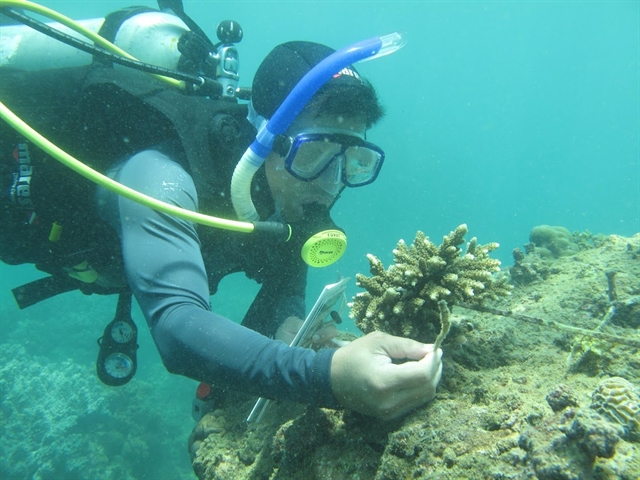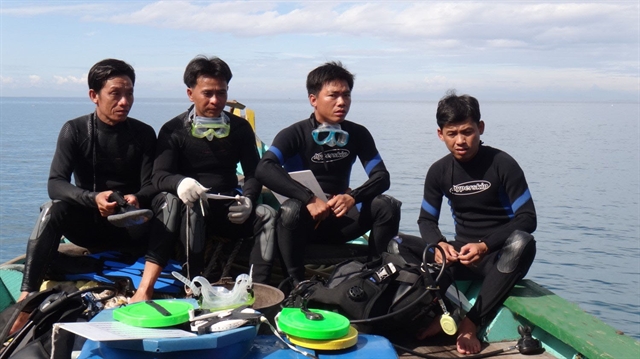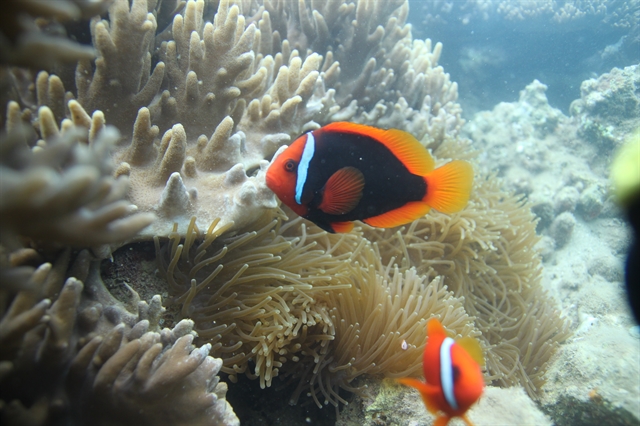 Opinion
Opinion

 |
| Lê Vĩnh Thuận takes a deep dive in water off the Chàm Islands to inspect coral reefs in the annual coral check programme by the Chàm Islands Marine Protected Area. Well protection of coral reefs off Chàm Islands makes it an attraction to tourists. Photo courtesy of Lê Vĩnh Thuận |
Coral reefs play a crucial role in marine biodiversity conservation, providing a safe shelter for fish and other aquatic species while protecting coastlines from erosion and climate change. Lê Vĩnh Thuận, deputy director of the Chàm Islands Marine Protected Area (MPA) and an expert in coral restoration, shares insights with Việt Nam News reporter Công Thành on coral reefs.
Can you tell us about the role of coral reefs in marine life protection and biodiversity conservation at sea?
Coral reefs are one of the most biodiverse ecosystems in the ocean, with significant ecological value. They serve as a safe haven for multiple marine species and are a valuable nursery for the development of sea products. Additionally, they create economic value by supporting ecotourism, particularly sightseeing and diving in well-preserved coral reefs.
Most local socioeconomic development programmes are based on environmental protection, ensuring minimal negative impacts on coral growth, the marine environment, and local communities. Economic growth must not harm the livelihoods of fishing communities or the sustainability of marine habitats and natural resources.
How do the Chàm Islands (off the coast of Hội An) restore and protect coral reefs through education and communication?
Education and communication have been top priorities since the Chàm Islands MPA was established. All island residents, from students to fishermen and business owners, receive education on marine environment protection and their responsibilities as local islanders. Many programmes are dedicated to school students—our main generation for future development—helping them understand the importance of coral reef restoration and marine protection in general. Good environmental stewardship will positively affect their future lives.
Students participate in various activities to broaden their knowledge of marine conservation, such as essay contests, painting competitions, and summer camps. A generation with strong awareness of environmental and marine protection has emerged from these community-based education programmes, which began 20 years ago. They are now active participants in educating the next generation on keeping the islands evergreen.
Most Chàm islanders have been aware of marine conservation and eco-friendly practices. The MPA also frequently collaborates with institutes, universities, and organisations to update the community's knowledge and provide training on marine protection.
 |
| Members of the coral check-up team of the Chàm Islands Marine Protected Area. Regular inspection programmes have helped coral reefs off Chàm Islands grow well over the past decades. Photo courtesy of Lê Vĩnh Thuận |
What successful programmes for community awareness improvement has the Chàm Islands MPA implemented in recent years?
One of the most successful initiatives has been helping the community transition to new livelihoods. The MPA estimates that 80 per cent of islanders have shifted to providing ecotourism services. Many old fishing boats have been upgraded for tourism activities, such as boat tours and diving excursions.
Children from fishing families operating in the strict protection zone within the MPA have been offered vocational training in mainland schools, helping to shift livelihoods away from overfishing.
Generations of islanders have received marine protection education, making the Chàm Islands community one of the most environmentally conscious in central Việt Nam. This has turned the islands into a favoured destination for other communities seeking to learn about environmental education and sustainable development.
The MPA management board continues to support and advise local households on transitioning to livelihoods beyond overfishing. We are also promoting alternative income sources, such as tourism services, homestays, tour guiding, and cruise operations. Traditional crafts, including hammock weaving, have been revived, along with the production of cakes and medicinal herb tea, and sustainable stone crab fishing.
 |
| Clown fish is found living in well-protected coral reefs off Chàm Islands. Marine products of Chàm Islands have been stable for years due to regular strict controls and community awareness education on coral reefs. Photo courtesy of Lê Xuân Ái |
What is the biggest challenge to the survival of coral reefs in the waters around Chàm Islands?
Most coral reefs are located on the west and southwest coasts of Lao Islet—one of eight islets around the Chàm Island proper—and in smaller areas at depths of around 14 metres.
Drift nets are widely used by local fishermen, but the lead sinkers of these nets stir up sediment on the seabed. While drift net fishing doesn’t directly damage coral reefs, the sediment can settle on them, causing harm. Additionally, using small mesh nets results in the capture of tiny, young fish with little value, contributing to a decline in natural resources.
Some countries have banned small mesh nets and enforced regulated fishing seasons. Dragnets, in particular, can cause damage to coral reefs and seaweed, while overfishing of coral reef-dependent species disrupts the entire ecosystem.
To combat these issues, the Chàm Islands authorities have expanded their no-fishing zones to protect marine species and limit fishing activities during spawning seasons.
The Chàm Islands-Hội An World Biosphere Reserve, spanning over 33,000 hectares, was recognised by UNESCO in 2009.
It includes 1,500 hectares of tropical forests and 6,700 hectares of sea, home to a rich diversity of marine fauna and flora. -- VNS




